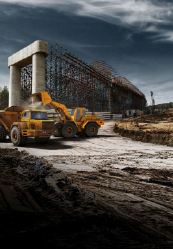Building the Unfailing Bridge with Bridge Inspection System Market
Bridges play a vital role in our transportation infrastructure, connecting communities and facilitating the movement of people and goods. However, with aging infrastructure and increasing traffic demands, ensuring the safety and integrity of bridges becomes extremely necessary.
This is where bridge inspection systems come into the picture. Let us inspect the importance of infrastructure inspection, explore the bridge inspection system market, and discuss its components, applications, and significance in maintaining bridge safety.
Global bridge inspection system market was valued at USD 0.98 billion in 2022 and is expected to reach USD 1.62 Billion By 2032, growing at a CAGR of 5.35% during the forecast period.
Why Is Inspecting The Bridge Crucial?
Infrastructure inspection is crucial for identifying potential structural issues, assessing the condition of assets, and prioritizing maintenance and repair efforts. Among various infrastructure elements, bridges require special attention due to their criticality and vulnerability to wear and tear. The bridge inspection system market has emerged as a solution to streamline and enhance bridge inspections, enabling more efficient and accurate assessments.
What Are Bridge Inspection Systems?
Bridge inspection systems are specialized tools and technologies designed to aid in the assessment, monitoring, and maintenance of bridges. The market for these systems is witnessing steady growth, driven by factors such as increasing infrastructure investment, government regulations emphasizing bridge safety, and the need for proactive maintenance practices.
To Get Insights on the Bridge Inspection Systems Market: Request for a Customized Report
Components Of The Safety System
The components of a bridge inspection system encompass hardware, monitoring systems, structural health monitoring software, and associated services. Let's explore these components in detail:
- Hardware
The hardware component of a bridge inspection system includes the physical equipment used for data collection and analysis. It comprises devices such as cameras, sensors, robotic systems, drones, and laser scanning equipment. These hardware components enable bridge inspectors to capture detailed visual data, measurements, and structural information.
- Monitoring System
Monitoring systems are an integral part of bridge inspection systems, providing real-time data on the performance and condition of bridges. They include various sensors and instruments to monitor factors like vibration, displacement, strain, and corrosion. Vibration sensors detect bridge vibrations and movements, while displacement sensors measure structural displacements.
- Structural Health Monitoring Software
The bridge inspection system market also offers advanced software solutions for structural health monitoring. These software applications process and analyze the data collected from sensors and provide valuable insights into the structural condition of bridges. They enable bridge engineers to identify potential issues, track structural performance over time, and make informed maintenance decisions.
- Services
In addition to hardware and software components, bridge inspection systems are complemented by various services. These services include calibration services to ensure accurate measurements, consulting services for expert guidance on inspection processes, integration services to seamlessly incorporate the system into existing infrastructure, and support and maintenance services to address any technical issues and ensure system reliability.
When And Where Are These Bridge Inspection Systems Used?
Bridge inspection systems find applications in a wide range of scenarios. They are used for routine inspections, condition assessments, load testing, and bridge health monitoring. These systems aid in identifying structural defects, evaluating the integrity of bridge components, and determining maintenance and repair needs. With their ability to capture detailed data and provide real-time insights, bridge inspection systems contribute to improved safety, extended asset lifespan, and cost-effective maintenance practices.
Concluding The Inspection
In conclusion, the bridge inspection system market is growing significantly as governments and infrastructure operators recognize the importance of maintaining safety and integrity. As our infrastructure continues to age, bridge inspection systems play a crucial role in ensuring the safety and longevity of our bridge networks, ultimately facilitating the smooth and secure movement of people and goods.


